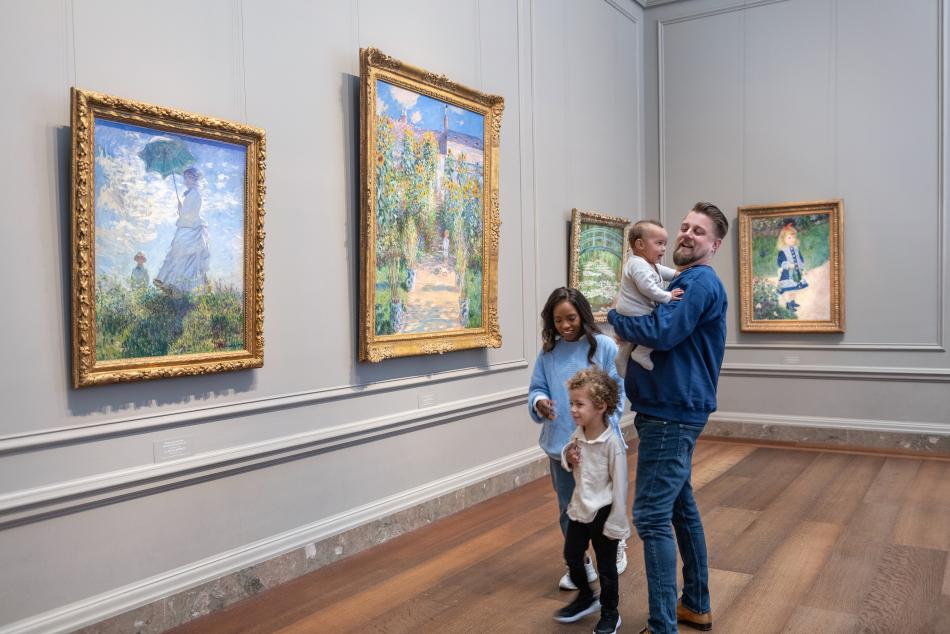
Dean’s Report
Center 45: Record of Activities and Research Reports
June 2024–May 2025
Steven Nelson, Dean
This academic year, some 30 fellows were in residence and another 12 fellows were remote, conducting research and writing in the United States and beyond, supporting a breadth of groundbreaking scholarship that furthers—and challenges—our knowledge of the visual arts. From June 2024 to May 2025, the Center also hosted 35 programs, directly engaging with members of the public, National Gallery staff, our advisory board, and fellows. Through our in-person, virtual, and hybrid formats, we reached audiences around the globe.
This year, we welcomed Mary Beard as our Kress-Beinecke Professor. She spent time working on three interrelated projects: a long-term study on the history and role of museums, a book on the continued importance of reading Greek and Latin classics, and an exploration of how modern art has illustrated and engaged with Ovid’s Metamorphoses. She also served as mentor to our predoctoral residential fellows, collaborating on projects with Center and National Gallery staff, and organizing a talk with predoctoral fellow David P. Bardeen on works in the National Gallery’s collection that feature stories from Metamorphoses.
In his first year as Andrew W. Mellon Professor, Roland Betancourt worked on two upcoming monographs. He also organized a seminar on the influence of Byzantine art in an international frame that includes examples from Africa, Asia, Europe, the Middle East, and North America, investigating the uses and purposes of Byzantine styles through the ages. The event’s proceedings will form our sixth Seminar Papers publication, shepherded by associate dean Kaira M. Cabañas.
Our publications team has been working on several volumes—including Art & Histories, the first book in our new series, Art &, forthcoming in 2026. As part of this initiative, Kaira and Gary Calcagno, associate projects manager, visited the Museu de Arte Contemporânea da Universidade de São Paulo for publications meetings and to attend the Center’s cosponsored lecture, “Water and Indigenous Participation in Brazilian Society” by Eliane Potiguara (Potiguara Nation), writer and founder of Grupo Mulher—Educação Indígena (Women’s Group—Indigenous Education). An edited version of Eliane Potiguara’s lecture will appear in Art & Water, the second volume in our new series.
As I write this, the Center’s Howard University Undergraduate Internship pilot program is in its last weeks. The 2023–2025 interns (Jada Brooks, Clay Cauley, Aletheia Couts, and Miles Kenyan Stewart) are finishing their second year, having joined several National Gallery departments—curatorial, library, conservation, and the Center—to support projects that advance institutional goals while building the interns’ professional skills. The cohort engaged in community events as well as programming with other National Gallery interns, including a professional development workshop. Over their two years at the National Gallery, the interns learned about museums and histories of art, created professional networks, and enhanced their workplace skills. This group visited colleagues at several New York City museums in January and attended the AUC Art Collective’s symposium “Black Art Futures” in February. Several of the program’s 12 interns have expressed interest in pursuing careers in arts-related fields. A member of the first cohort, Munyang Tengen, currently works in the National Gallery’s conservation division and is a participant in the Getty-sponsored Conservation Workshop for HBCU Students. Working with materials from the famed Johnson Publishing Company Archive, the program aims to introduce conservation as a potential career path. The National Gallery has learned as much—or more—from the interns as they have from us. This coming fall, as part of satisfying the terms of the Mellon Foundation grant, the Center will create a manual to help institutions that are interested in designing undergraduate internships, including lessons learned.
In the spirit of the Center as a hub for exchanging ideas, we began and ended our academic year with public discussions. In September, Jennifer L. Roberts and I discussed her book, Contact: Art and the Pull of Print, the most recent of our Mellon Lectures volumes produced with Princeton University Press. It was a pleasure to welcome her to the National Gallery and to revisit her 2021 Mellon Lectures, which formed the basis for the volume. This year, we also had the wonderful opportunity to host two scholars studying ancient Greece and Rome. Mary Beard and Hugo Shakeshaft, A. W. Mellon Postdoctoral Fellow, discussed beauty and the divine in ancient Greece on the occasion of Hugo’s new book, Beauty and the Gods: A History from Homer to Plato.
In the fall, we were thrilled to welcome back Emily Braun, 2020 Edmond J. Safra Visiting Professor, to convene a colloquy titled “Poetry and Painting.” About three weeks after Emily’s arrival in 2020, the National Gallery shut down due to the COVID-19 pandemic, and she smartly packed up her car and returned to New York City. While she shared a wonderful online discussion of her research, the colloquy, which is at the heart of the Safra experience, did not take place. Several years later, participating scholars and poets explored the relationships between painting and poetry, thinking in verse and prose what each can learn from the other.
In conjunction with the exhibition Paris 1874: The Impressionist Moment, the Center hosted a study day and public program that encouraged a global view of impressionism beyond Paris. From conversations in the exhibition’s galleries to public presentations and discussions, our participants’ compelling research and observations broadened our understanding of impressionism and the contexts in which it emerged and thrived.
We were immersed in the world of Caravaggio by Keith Sciberras of the University of Malta for the 28th annual Sydney J. Freedberg Lecture on Italian Art. From his incisive insights into Caravaggio’s 1608 painting, The Beheading of Saint John the Baptist, to his provocative presentation on uncovering information in archives, Professor Sciberras gave us much to ponder and new possibilities for understanding artworks. You can watch and share a recording of his lecture, “Blood Joining Blood: The Immersive in Caravaggio’s Malta.”
Now in its 55th year, the Center cosponsored the Middle Atlantic Symposium in the History of Art with the University of Maryland. Held each March, it features a day of presentations by graduate students from the mid-Atlantic region. The National Gallery’s chief curatorial and conservation officer E. Carmen Ramos kicked off the symposium in College Park with her moving lecture, “Freddy Rodríguez: The Geometry of Freedom,” a long-term research project on the Dominican American artist.
The Center’s Accademia di San Luca research project, directed by associate dean Peter M. Lukehart, had a banner year. In the fall, Peter was invited to speak at the Palazzo Braschi on the occasion of the exhibition Roma Pittrice: Artiste al lavoro tra XVI e XIX secolo. He delivered a talk on the documentary, literary, visual, and historical evidence for women artists who became academicians at the Accademia di San Luca, whether “by honor” (a title reserved for members of the social elite) or “by merit” (those who gained fame through their artistic practice). An essay on the same subject will appear in Academies of Art in Europe and the Americas, 1600–1900, the fifth volume in our Seminar Papers series. The project also published new essays by Evelyn Lincoln and Susan Nalezyty focusing on the Italian printmaker Girolama Cagnaccia Parasole (c. 1567–1622), the first documented woman member of the Accademia di San Luca. In celebration, on March 8, the Accademia team organized a daylong event with the National Gallery of Art Library, including a lecture by Evelyn Lincoln, a small exhibition of rare books and prints, and a Wikipedia edit-a-thon to create and improve articles about Girolama, her family, and the Accademia. You can view their progress from the event here.
March also welcomed the 74th A. W. Mellon Lectures in the Fine Arts. Mabel O. Wilson, Nancy and George E. Rupp Professor of Architecture, Planning and Preservation and professor and chair of the African American and African Diaspora Studies Department at Columbia University, delivered her four-part series, America’s Architecture of Freedom and Unfreedom, which explored key themes and examined buildings, works of art, and other historical documents through the interplay of race and the construction of national identity. The lectures were a resounding success. Extraordinarily rigorous in their research, the series deepened our understanding of the early architecture and construction of Washington, DC.
I write this shortly before retiring as the dean of the Center for the Advanced Study in the Visual Arts. I am proud of what we have accomplished since 2020. Through the Mellon Foundation–funded Howard University Undergraduate Internship, embracing broader forms of research and scholarship, bringing myriad kinds of expertise together, and opening our programs to wider audiences, the Center has become an expansive laboratory for the production of knowledge and exchange of ideas. Learning about the incredible array of projects by Center fellows and guests, working with the Center team, and partnering with the National Gallery of Art has been an honor. I will cherish this experience always.


